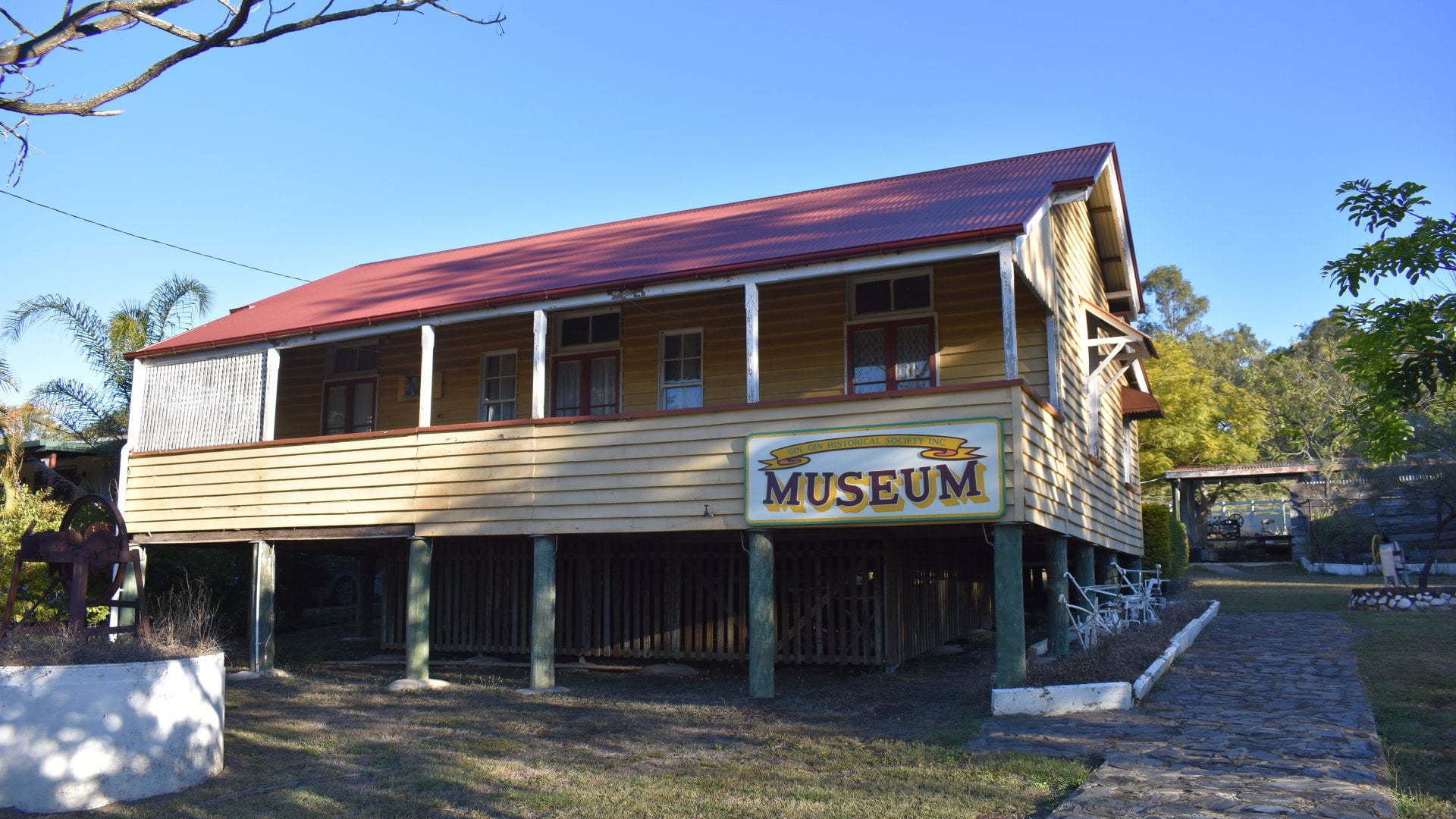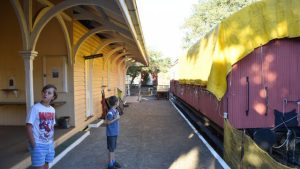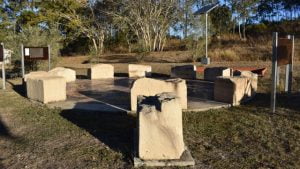
The Gin Gin Historical Village is located at the disused Gin Gin Railway Station, on the branch rail line from Bundaberg. The village area is quite large will a lot to look at.
We arrived on a Sunday afternoon so it was quiet and deserted, so we didn’t get to look inside the museum buildings but you can still wander around the grounds with plenty to see.
At the front is the Gin Gin & District Historical Society Museum building. Entry is a measly $2 per person with children under 12 free. They operate by volunteers and donations, so a bit extra if you can spare it is welcomed.
Across to the right is another building with a museum sign on it. I’m unsure if this building is open in addition to the building when you first enter. Further along is a couple of slab hut buildings.

Behind the buildings is the railway station building with the platform on the other side and rail carriages are on the tracks. The construction of the railway line from North Bundaberg started in 1879 and opened through to Moolboolaman (west of Gin Gin) in 1881, and another year to reach Gillens Siding with a number of bridges over creeks needed to be built.
The third stage required the railway to cross the Boolboonda Range by means of a tunnel ![]() , taking the railway line to Mount Perry and the copper mines
, taking the railway line to Mount Perry and the copper mines ![]() in 1884.
in 1884.

On the other side of the tracks is an area dedicated to the Taribelang people, the traditional owners of the Gin Gin country. Pastoralists cleared the land and introduced livestock, destroying important flora food sources and contaminating water supplies used by the Taribelang people.
The Taribelang people strategically defended their country by killing the livestock and burning the crops. After the spearing of two shepherds in 1849, a punitive expedition led by Gregory Blaxland was the first massacre, then after Blaxland was found dead 12 months later, the second massacre of Taribelang people occurred by a punitive expedition formed by pastoralists.
Descendants of the few surviving Taribelang people who escaped across the river into the Woongarra Scrub are still in the area. The project was created in a partnership between Gin Gin State High School, Jinjinburra Aboriginal Corporation, the Gin Gin Historical Society, and the Bundaberg Regional Council with 100 people working on it.
At the far end towards the right is Bunyip, an old steam locomotive which commenced work in 1896 and continued for about 66 years when it ceased work around 1962.
A stump of a Blaze Tree sits near Bunyip. Trees were used as survey marks on the roads before concrete markers were introduced. Some blaze trees date back to the 1920s but the age of this stump is not known. R 14 1/2 is partly seen carved in the side with the bark growing over making it hard to read.
Saturday mornings bring the markets where you can buy local fresh produce, arts and crafts, 2nd hand goods, and a variety of other things.
To get there:

Coming into Gin Gin from the south on Bruce Hwy, turn right towards Bundaberg into Mulgrave St (Bundaberg Gin Gin Rd) with a brown sign for Historical Village shortly before it. Gin Gin Historical Village is about 200m on the right.
Coming into Gin Gin from the west on Bundaberg Gin Gin Rd, the Historical Village entrance is about 1.1km coming into town with a brown sign for Historical Village at the entrance.
Coming into Gin Gin from the north on Bruce Hwy, continue for 2.7km through the town after crossing the bridge over Gin Gin Creek and turn left into Mulgrave St (Bundaberg Gin Gin Rd) with a brown sign for Historical Village shortly before it. Gin Gin Historical Village is about 200m on the right.
Coming from Mount Perry or Boolboonda Tunnel, head west towards Gin Gin to the end and turn right onto Bruce Hwy. Continue for 2.1km through the town and turn left into Mulgrave St (Bundaberg Gin Gin Rd) with a brown sign for Historical Village shortly before it. Gin Gin Historical Village is about 200m on the right.
Cost General: Free
Cost Museum: Adult $2, Child (Under 12) Free
Hours General: Anytime
Hours Museum: Mon-Fri 8.30am-2.30pm
Hours Markets: Sat 7am-11am
Toilets: Yes
Bins: No
Tables: Yes
Seating: Yes
Water: No
Food: No, Saturday markets may have food
Wheelchair accessible: No
Pets: No
BBQ: No
Playground: No


